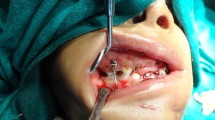Abstract
Purpose
Is to compare the patterns, severity, and management of the high- and low-velocity mandibular war injuries managed at Al Shaheed Gazi Al-Hariri Hospital in Baghdad Medical City, Iraq, during a 2-year period.
Methods
Forty-one patients with a history of mandibular war injuries treated by our maxillofacial team were reviewed during a period of 2 years (2015–2017). All patients were treated in the Maxillofacial Unit of the Hospital of Specialized Surgeries in Baghdad Medical City.
Results
A 2-year retrospective study evaluated 41 patients with mandibular war injuries with a total of 94 fractures (comminution represents 79.06% of the bullet injuries, while it is only 62.74% with IED injuries). Management of these injuries was varied according to the severity of the injuries and resources available. Close reduction was used in 72.72% of the linear fracture cases, whereas open technique was used in 56.6% of the comminuted fractures.
Conclusions
Bullet injuries were associated with a higher number of mandibular comminuted fractures, in addition to more extensive bone loss. While shell injuries of IED (improvised explosive devices), on the other hand, were associated with higher infection rate and more postoperative complication.



Similar content being viewed by others
References
Peled M, Leiser Y, Emodi O, Krausz A (2012) Treatment protocol for high velocity/high energy gunshot injuries to the face. Craniomaxillofac Trauma Reconstr 5(01):031–040
Perry M, Brown A, Banks P (2015) Fractures of the facial skeleton. Wiley
Cohen MA, Shakenovsky BN, Smith I (1986 Jan 1) Low velocity hand-gun injuries of the maxillofacial region. J Maxillofac Surg 14:26–33
Breeze J, Tong D, Gibbons A (2017 May 20) Contemporary management of maxillofacial ballistic trauma. Br J Oral Maxillofac Surg
Ramasamy A, Hill AM, Clasper JC (2009) Improvised explosive devices: patho-physiology, injury profiles and current medical management. J R ArmyMed Corps 155:265–272
Breeze J, Opie N, Monaghan A et al (2009) Isolated orbital wall blowout fractures due to primary blast injury. J R Army Med Corps 155:70.6
Shuker ST (2010) Maxillofacial air-containing cavities, blast implosion injuries, and management. J Oral Maxillofac Surg 68:93–100.5
Kummoona R (2011) Missile war injuries of the face. J Craniofac Surg 22:2017–2021
Bataineh AB (1998) Etiology and incidence of maxillofacial fractures in the north of Jordan. Oral Surg Oral Med Oral Pathol Oral Rehabil Radiol Endod 86(1):31–35
Olasoji HO, Tahir A, Arotiba GT (2002) Changing pictures of facial fractures in northern Nigeria. Br J Oral Maxillofac Surg 40(2):140–143
Tanaka N, Tomitsuka K, Shionoya K, Andou H, Kimijima Y, Tashiro T, Amagasa T (1994) Aetiology of maxillofacial fracture. Br J Oral Maxillofac Surg 32(1):19–23
Heimdahl A, Nordenram A (1977) The first 100 patients with jaw fractures at the Department of Oral Surgery, dental school. Huddinge Swed Dent J 1(5):177–182
Marker P, Nielsen A, Bastian HL (2000) Fractures of the mandibular condyle. Part 2: results of treatment of 348 patients. Br J Oral Maxillofac Surg 38(5):422–426
Khalil AF (1980) Civilian gunshot injuries to the face and jaws. Br J Oral Surg 18(3):205–211
Ugboko VI, Owotade FJ, Oginni FO, Odusanya SA (1999) Gunshot injuries of the orofacial region in Nigerian. SADJ 54(9)
Singh V, Malkunje L, Mohammad S, Singh N, Dhasmana S, Das SK (2012) The maxillofacial injuries: a study. National journal of maxillofacial surgery 3(2):166–171
Finn RA (1996) Treatment of comminuted mandibular fractures by closed reduction. J Oral Maxillofac Surg 54(3):320–327
Bede SY, Ismael WK, Al-Assaf D (2017) Characteristics of mandibular injuries caused by bullets and improvised explosive devices: a comparative study. Int J Oral Maxillofac Surg 46(10):1271–1275
Ellis E, Muniz O, Anand K (2003) Treatment considerations for comminuted mandibular fractures. J Oral Maxillofac Surg 61(8):861–870
Holleran RS (ed) (2003) Air and surface patient transport: principles and practice. Mosby Incorporated
Kakkar A, Kochhar LK (2000) Missile injuries of face and neck: our experience. Indian J Otolaryngol Head Neck Surg 52(4):334–339
Author information
Authors and Affiliations
Corresponding author
Ethics declarations
All procedures performed in studies involving human participants were in accordance with the ethical standards of the institutional and national research committee and with the 1964 Helsinki declaration and its later amendments or comparable ethical standards.
Conflict of interest
The authors declare that they have no conflict of interest.
Informed consent
Informed consent was obtained from all individual participants included in the study.
Rights and permissions
About this article
Cite this article
AL-Anee, A.M., Al-Quisi, A.F. & Al-jumaily, H.A. Mandibular war injuries caused by bullets and shell fragments: a comparative study. Oral Maxillofac Surg 22, 303–307 (2018). https://doi.org/10.1007/s10006-018-0710-1
Received:
Accepted:
Published:
Issue Date:
DOI: https://doi.org/10.1007/s10006-018-0710-1




